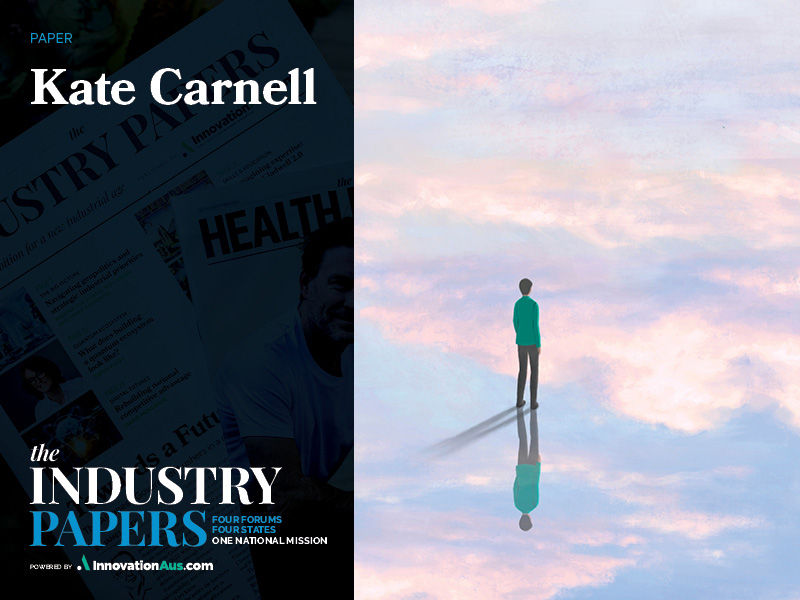We are well-practised in navigating the predictable milestones – youth, puberty, parenting – and we’re becoming more familiar with menopause and mental health. However, when it comes to dying – whether it’s coming to the natural end of a well-lived life, or because of chronic life-limiting illness – we’re hopelessly avoidant. We don’t talk about it and we don’t plan for it. For most people, it’s a complex, disorganised, expensive, over-medicalised experience filled with regret.

Many of my political and professional roles intersect with Australia’s health and aged care systems. Despite this, when it came to caring for my own parents through the last stages of their lives, I faced so many challenges in having important conversations, understanding what was most important to them, and ensuring a plan was in place to deliver what they wanted. My parents simply didn’t have the experience that they wanted, which is something I will always regret.
Public health systems nationwide are strained, dysfunctional, and overwhelmed. Hospitals are grappling with bed blocks, elective surgery delays, emergency department overcrowding, and ambulance ramping.
A new evidence-based review reveals a startling truth: at least a quarter of all hospital beds are occupied by patients in their last year of life, predominantly the elderly frail. Ironically, many of these patients do not wish to be hospitalised, preferring to spend their final days at home or in a home-like setting.
Research indicates that dying patients often receive high-intensity care without clear benefits, often at odds with their known preferences.
The combination of a death-denying society and a cure-focused health system creates hazardous complicity, a significant cost burden ($4 billion annually) and drives up expenses and waste across Australia’s health and aged care systems.
People in the last stage of life deserve comfort, dignity, and compassionate care in their place of choice. Sadly, today’s system is not sufficiently geared towards these wishes and preferences.
The ageing population will lead to exponential increases in deaths each year. In the coming decades, the number of Australians aged 65 and over will double. Those aged 85 and over will more than triple.
This is the ‘Silver Tsunami’ and, as a society, we are not prepared for it. Today’s systems and social norms are insufficient for Australia’s ageing citizens and those who will care for them. Without significant change at the policy level, we may be sleepwalking into this century’s biggest macrosocial and economic crisis.
These issues affect everyone, as the aging population will put growing pressure on Australia’s health system, reducing bed availability and limiting hospital services like elective surgery.
It is sad and disheartening for a nation like ours that so many individuals are denied the dignity of dying in the place and environment they choose. While we have established norms and comprehensive services and support for all other life stages, the final stage of life remains taboo and overlooked. All too often, we do too little, too late.
Urgent need for end-of-life planning
The crisis in our public health systems is a regular headline. Each year, approximately 180,000 Australians die, and over 50 per cent die in hospital – our least preferred place to die. Most would rather spend their remaining time at home or in a home-like environment. Yet 70 to 80 per cent of hospital deaths involve frail older patients admitted as emergencies.
Violet recently released a review of global research regarding the most relevant issues for people during their last 12 months of life. The review highlights a terrible mismatch between people’s expectations and preferences about how they spend their final months and weeks and the reality, which is driving huge amounts of cost and waste across our health and aged care systems.
In the last 12 months of life, people average four hospital episodes and 33 days in hospital.
Research shows that many dying patients receive high-intensity care without clear evidence of benefits, often at odds with their known preferences.
A significant portion of patients, up to 38 per cent, undergo treatments that don’t benefit them in their final moments.
Those who die in residential aged care incur half the costs of those who die in hospital.
Healthcare costs associated with the last stage of life are driven by increased hospitalisations, non-beneficial treatments and extensive use of ambulance services. These costs are notably higher in the final 6-month to 12 months of life, with per capita healthcare expenditures up to four times higher than for individuals not at the end of life.
While methodologies vary, research indicates that eight to 11 per cent of Australia’s total health expenditure was for people in their final year of life. This outlay was 17 times as the total cost for people not in the last year of their life.
There are a number of forces driving these regretful and costly outcomes. While most deaths are predictable and can be planned for the reality is that people struggle to accept, talk about and plan for this life stage.
Unsurprisingly, the attitudes and preferences of the person in the last stage of life are not discussed, understood, or advocated for. Only 14 per cent of Australians have a plan in place for the end of life, and arguably, far fewer would be considered ‘meaningful’ plans.
Poor planning and preparation, rushed decision-making, complex family dynamics and misaligned care goals all contribute to the problem.
The need for change
Despite its ubiquity, significant system cost burden and the looming pressures of an ageing population, there has been limited investment and innovation across this life stage. The continued cost of doing nothing is simply too high – for our health and aged care systems, for individuals, their families, and their caregivers.
It is time to assess the human and economic costs of the last stage of life and explore new models that relieve system pressures while improving care, support, and outcomes. These are problems worthy of attention and investment as part of our duty of care for Australia’s ageing citizens and those who care for them.
The 2022 Lancet Commission Report on the Value of Death calls for a new vision for dying, emphasising community involvement and better bereavement support. Similarly, the World Economic Forum highlights the need to rethink our approach, noting that health spending accounts for 10 per cent of the global economy, underscoring the potential for technology to lower costs and enhance health outcomes for more sustainable healthcare systems.
It’s time to rethink and rebalance how we deal with the last stages of life. This cultural shift will require a lot more than “awareness campaigns” but specific policy changes, employer support, and increased social, emotional, and community support.
While the issues are complex, actionable steps can be taken to make progress in the short to medium term. It is increasingly clear that digital technologies must play a critical role in new models and solutions to ensure scale and sustainability.
Across the last stage of life, better care and lower costs can be realised by focusing on:
Understanding what’s most important to people in the last stage of life,
Engaging people, families and caregivers early, to have conversations and put a plan in place, and
Developing innovative technology solutions to ease the burden of ‘sadmin’—the emotional and disorganised tasks of this life stage, including gathering information, coordinating care, managing legal documents, and planning funerals.
A new model of care for the last stage of life
Leveraging insights from the recently released report ‘Too little, too late: the experience of people through the last stage of life’ as well as more than 25 years of expertise, The Violet Initiative proposes a series of feasible, sustainable, and practical actions that can be implemented to assist governments, health and aged care providers, and not-for-profits address these issues.
1. Help people to talk about this life stage so that they are confident enough to have meaningful discussions with loved ones and can make informed and supported choices about what matters most to them.
2. Provide tools and resources to build capacity, put a meaningful care plan in place, and be better prepared and supported through the last stage of life – whether planning ahead for themselves or caring for a loved one.
3. Help with navigation so they understand the range of services available at different stages through the last stage of life and can access them as needed.
4. Provide personalised and convenient support at scale to ensure the support is tailored in response to their circumstances and level of emotional readiness, cultural context and language of preference.
5. Support and upskill health and aged care staff to feel more confident and willing to talk about, and help people plan for the last stage of life, and to be able to direct them to useful information and resources.
6. Improve information flow, data capture and interoperability across systems in the care sector. Establish a unique data set about the last 12-18 months of life that informs policy and practice.
Over the past few decades, we’ve seen incredible progress on social issues that impact health and well-being, from mental health awareness to smoking cessation. These advancements have fostered open conversations, established new social norms, and built support systems that have led to better societal outcomes. Now, it’s time to turn our attention to improving the experience of life’s final chapter.
I am passionate about addressing these needs to ensure that people have the experience that they want and deserve. I’m excited about the potential of new technologies to introduce novel, personalised, and empathetic solutions to address this at scale.
I look forward to working broadly with the government and the sector to change the way society manages the last stage of life—to ensure that Australians, families, and caregivers have the best possible experience.
Kate Carnell, Chair, The Violet Initiative. Kate Carnell is an Australian leader known for her contributions to healthcare, business, and public policy. She currently serves as the chair of the Violet Initiative, which focuses on transforming the last stage of life. She is the chair of Mable and the Australian Made Campaign Ltd. And is also the deputy chair of Beyond Blue. Kate was the Chief Minister of the Australian Capital Territory from 1995 to 2000. A pharmacist by profession, she is a respected advocate for mental health and small business and is an Officer of the Order of Australia (AO), awarded in recognition of her public service.
This article is part of The Industry Papers publication by InnovationAus.com. Order your hard copy here. 36 Papers, 48 Authors, 65,000 words, 72 page tabloid newspaper + 32 page insert magazine.
The Industry Papers is a big undertaking and would not be possible without the assistance of our valued sponsors. InnovationAus.com would like to thank Geoscape Australia, The University of Sydney Faculty of Science, the S3B, AirTrunk, InnoFocus, ANDHealth, QIMR Berghofer, Advance Queensland and the Queensland Government.
Do you know more? Contact James Riley via Email.

